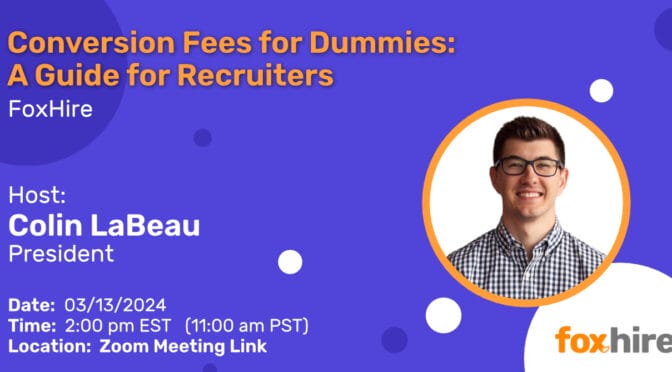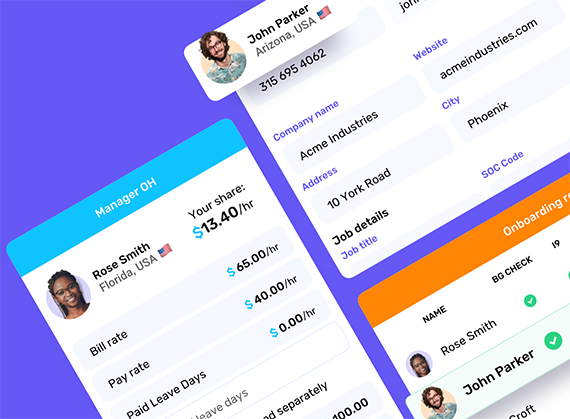Third-party vendors in the HR space are particularly helpful for companies that want to streamline their operations. Companies like FoxHire offer employers a way to outsource the risks and complexities of labor while allowing their internal teams to focus on the mission of the company. Simply put, we handle all the small details of managing your workforce so you can focus on the art and science of business building. But when you start to look at outsourcing your HR, you’ll find two types of third parties cropping up: a Professional Employer Organization (PEO), and an Employer of Record (EOR).
What’s the difference between a PEO and EOR?
Bottom line, the main difference between a PEO and an EOR is the concept of “co-employment”. EORs do not offer co-employment and take on the liability almost entirely, while PEOs do offer co-employment but share the liability.
What is a PEO?
A PEO works with their client companies to handle processing their payroll, administering benefits, handling tax filings, and more. Some of the characteristics of a PEO include:
- Co-employment of your workforce. This is a big point of differentiation between an EOR and PEO. With a PEO, you are both legal employers of your workforce. However, you handle the daily oversight of your employees while the PEO does the paperwork.
- If you work with a PEO, you must still register your business in the state where you’re hiring.
- A PEO provides a shared employee pool for better purchasing power when looking at employee benefits.
- A PEO only handles your full-time permanent workforce. You must still handle any temp, part-time, or flex talent.
As you’ll see, a PEO has some big differences from an EOR. Which business partner you choose depends on your resources and overall operational plan.
What is an EOR?
An EOR has a broader scope for what they can do for your business, by handling everything from onboarding to payroll, taxes, benefits, unemployment, workers’ compensation—and more. Some of the characteristics of an EOR include:
- An EOR is the full legal employer of your talent, and as such, is responsible for handling the risks associated with labor laws and other compliance issues in each state you do business in as well as nationally.
- An EOR is registered in all states, so you can look for talent anywhere and let them handle the paperwork.
- An EOR also offers a shared pool for employee benefits and manages the complexities of these arrangements on your behalf.
- An EOR handles all types of employee relationships, from full-time permanent workers to part-time, freelance, and more.
- An EOR is usually quite scalable, so they can handle dozens or hundreds of employees as your business grows.
Employment Categories
To create a further distinction between these services, let’s look at specific employment categories and see how these two types of services matchup:
- Insurance – If you hire a PEO, you are on your own for insurance. An EOR holds the insurance and handles compliance and fees associated with coverage like worker’s compensation and healthcare.
- Business registration – If you’re considering expanding your workforce across the country into new states, you probably need an EOR. An EOR lets you employ workers in states where you are not even registered as a business. This is a huge benefit over a PEO because each state has wide-ranging rules around employment, and they are all different and subject to change.
- Hiring and Onboarding – When it comes to HR functions like hiring, onboarding, terminations, employee reviews, unemployment taxes, and administering health insurance – A PEO shares responsibilities and aren’t usually equipped to handle all of these functions collectively. However, an EOR is (or should) be able to handle all of these thing for you.
- Employee Classifications – This is the most significant difference between an EOR and PEO. The employer relationship service arrangement with a PEO allows the third-party organization to step in and administer HR functions. The liability for hiring still rests with your company. With an EOR, full administration and liability of the employee/employer relationship lies with the third-party organizations. A contract for employment, in this case, is between the EOR and the worker.
Think of a PEO as a co-employer and an EOR as being on an equal footing with any company that hires employees. EORs are often nationwide organizations, registered in all 50-states or in some cases globally, which is a big benefit for smaller companies seeking to expand their workforce without the liability and hassle of state registration rules.
Is Co-Employment legally aloud outside of the USA?
Co-Employment payroll relationships have been legally recognized by the United States. In fact, through lobbying by organizations such as NAPEO, the IRS has even created a special certifications for PEOs. This has codified the legal statute of co-employment, and creates greater transparency for PEOs to demonstrate their capabilities and trustworthiness. However, co-employment is not legal in most other countries, including Canada. Many companies marketing “international PEO” services are truly just using that term for marketing purposes. Since co-employment is not legal in many other countries, these organizations just market “PEO” services, while actually operating as an EOR.





